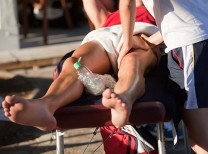Many people with osteoarthritis (OA) or “bone on bone” changes ignore exercise or minimize movement due to the myth that it will further damage their joints. They often manage their pain with medication while simply waiting to get their joint replaced.
Approximately 14 million people have symptomatic OA, however, patients do not have to live with years of knee or hip pain, and movement, mobility, and strength can help.
Causes of osteoarthritis. The knee and hip are the two freely moving joints most affected by OA. It is a progressive disease caused by inflammation and degeneration of joints and progression is influenced by age, body mass index (BMI), bone structure, genetics, muscular strength and activity level. Knee OA may also develop as a secondary condition following a traumatic knee injury.
As OA progresses, articular cartilage begins to soften and demonstrates a less smooth surface, while the underlying bone may increase due to extra stress as the cartilage matrix becomes disrupted. Pain occurs when the cartilage wears down. Excessive stress (increased weight/height ratio, excessive exercise without sufficient rest, etc.) contributes to early cartilage breakdown.
Symptoms include worsening pain during climbing, or moving from a standing to sitting position, and popping, cracking, or grinding when moving the knee. These symptoms do not occur suddenly but develop gradually over time.
Non-invasive treatment options. Depending on the stage of the disease and whether there are associated conditions or injuries, OA can be managed with physical therapy. Individuals often move in a way that is inefficient or places undue stress on their joints; a physical therapist can show you how to modify your activity to ease the stress.
During your diagnosis, a therapist will measure your range of motion, strength, mobility, and flexibility. You will perform various movements to see if they increase or decrease pain. Your physical therapist will design a whole-body, individualized treatment program specific to your condition. Range of motion exercises will focus on improving your ability to bend and straighten your knee and improve flexibility for increased motion. Activity is prescribed based on the type, frequency, duration and intensity of your condition and your program is monitored to avoid excessive stress on the impacted joint and to allot adequate time for rest and recovery.
Prevention. Inactivity is a significant contributor to many problems that affect OA. In fact, current research indicates that individuals with knee OA who walk more steps per day are less likely to develop functional problems in the future. Exercise to strengthen the muscles around the knee and surrounding joints is important to decrease stress to the knee joint, improve flexibility and keep the cartilage healthy.
Take a “whole body” approach to managing your OA. Lack of strength, mobility and flexibility in surrounding areas of the body such as the ankle, hip, and spine can affect degenerative joints.
Weight loss will also decrease the stress on the joint, which in turn will lessen the erosion of the protective cartilage and prolong the onset of OA.
The conclusion? Get moving, stay active, and remember…motion is lotion for the body and joints!
Drs. Gentry and Kambe are orthopedic certified specialists and clinic directors for Avid Physical Therapy. They can be reached at [email protected] and [email protected]. For more information, visit www.AvidPhysicalTherapy.com.
Sources available upon request.











































Comments (0)